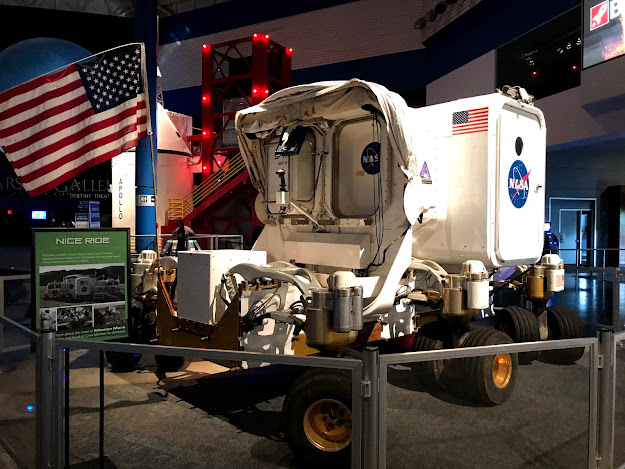At this point, we've driven north, south and west from San Antonio, so it was time to drive east to Houston and our destination was the Johnson Space center. I visited back in 2007 but there are new displays, like the Space Shuttle and the Shuttle Carrier, which ARE TOTALLY COOL
 |
| It took awhile to get into the flow of the museum, but what eventually got me "into the zone" was the timeline of the missions. We've heard of Mercury, Gemini and Apollo, but I finally understood the timeline and how each mission built upon a previous one. |
 |
Here we are enjoying the simulator experiencing takeoff and landing!
|
 |
One of the highlights is a tour of the building where they house the Saturn V rocket (one of the three remaining) which is what the Apollo program used to land the astronauts on the moon.
|
 |
Here's one of the Saturn V predecessors.
|
 |
Here's the Saturn V as we look from the "base" or the first phase rocket.
|
 |
These five boosters fire for two and a half minutes and then the first phase rocket disengages from the Saturn V.
|
 |
The second phase booster. This one fires for six minutes (I think that's what I heard) and then it disengages but burns upon entering the Earth's atmosphere.
|
 |
Third Stage booster fires twice, once for almost three minutes and the second for almost four minutes.
|
This empty space in the Service Module holds the Lunar Module
 |
The Command Module and the Escape System
|
Turns out the Apollo program scheduled 20 missions but cancelled the last three. However, the rockets had already been built so the remaining three are on display at the three NASA space centers.
 |
| Part of the original mission control. So 60's looking. Turns out there are tours to the Mission Control but due to COVID-19, those tours were closed. |
 |
Rocks from the moon. Totally cool.
|
 |
After the Apollo program, NASA had the Space Shuttle program from 1981-2011. Here is the Space Shuttle Independence and the Shuttle Carrier. Alas, according to Wikipedia, the Indpendence (formerly known as the Explorer) is a replica and never was launched into space.
|
 |
| Inside the Space Shuttle looking into the payload area. |
 |
The airlock area where astronauts prepared for space walks.
|
 |
I actually found the shuttle carrier to be much more interesting. Turns out for weight distribution purposes, they had to put ballast in the nose area....so long first class!
|
 |
In addition, to support the weight of the shuttle, the rounded supports had to be added to the fuselage of the 747.
|
 |
A 747 engine from the rear.
|
 |
The vertical stabilizers added to the rear wings of the 747.
|
 |
One of the things I didn't realize is how specialized the tools must be. I bet there are people who's entire job must be to design and craft a took for specific use in space and for a specific task.
|
 |
| There was a large exhibit about the Apollo 13 mission. Here's a mock up of the famous air-filter that they designed from parts they had in space. |
 |
| The Moon Car (I forget the official name) |
 |
The only ongoing mission is the International Space Station. I wish there had been much more explanation of how the Space Station works (as in what all those parts up there are doing).
|
 |
A look at the hatch that connects the space craft to the ISS
|
 |
| The Falcon X, which is the first reusable fuel rocket. In the past, they just fell into the ocean, but this Falcon X was used twice most recently in 2017. It's part of the SpaceX program to explore Mars. |
 |
As I was leaving, I was channelling the episode from The Crown where Prince Phillip is floored by the accomplishment of humans on the moon. I was thinking how amazing science is and the power of collaboration and smart people working towards a common goal.
|
 |
Upon leaving the Johnson Space Center, Onions located the "Southern California" of Houston...we found the Chinese strip malls and got to dine in. I'm starting to realize how much I dislike takeout and how much I value the simple act of dining without having to think about where you will actually eat.
|
 |
Once again, Onions ordered better than me. Typical.
|












































No comments:
Post a Comment